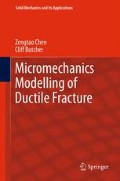Abstract
Experimental evidence and numerical simulation have established that ductile damage critically limits the formability of sheet metals (Gelin 1998; Hu et al. 2000; Tang et al. 1999). To accurately predict formability and to optimize material processing to achieve enhanced formability, it is important to understand how heterogeneously distributed micro-defects affect the macromechanical behaviour of sheet metal. Therefore, it is of both theoretical and practical interest to investigate damage evolution during sheet metal forming.
Access this chapter
Tax calculation will be finalised at checkout
Purchases are for personal use only
References
Brown, L. M., & Embury, J. D. (1973). The initiation and growth of voids at second phase particles. In Proceedings of the 3rd international conference on the strength of metals and alloys (pp. 164–169). London: Institute of Metals.
Chen, Z. T. (2004). The role of heterogeneous particle distribution in the prediction of ductile fracture. Ph.D. thesis, University of Waterloo, Canada.
Chen, Z. T., & Worswick, M. J. (2008). Investigation of void nucleation in aluminum alloys. Materials Science and Engineering A, 483–484, 99–101.
Chu, C. C., & Needleman, A. (1980). Void nucleation effects in biaxially stretched sheets. Journal Engineering Materials Technology, 102, 249–256.
Cinotti, N. (2003). Stretch flange formability of aluminum alloys. M.Sc., thesis, University of Waterloo, Ontario, Canada.
Gelin, J. C. (1998). Modelling of damage in metal forming processes. Journal of Materials Processing Technology, 80–81, 24–32.
Gurson, A. L. (1977). Continuum theory of ductile rupture by void nucleation and growth – Part I. Yield criteria and flow rules for porous ductile media. Journal of Engineering Materials and Technology, 99, 2–15.
Hu, J. G., Ishikawa, T., & Jonas, J. J. (2000). Finite element analysis of damage evolution and the prediction of the limiting draw ratio in textured aluminum sheets. Journal of Materials Processing Technology, 103, 374–382.
Orlov, O. (2003). Private communications.
Pilkey, A. K. (1997). Effect of second phase particle clustering on aluminum-silicon alloy sheet formability. Ph.D. thesis, Carleton University, Ottawa, Canada.
Tang, C. Y., Chow, C. L., Shen, W., & Tai, W. H. (1999). Development of a damage-based criterion for ductile fracture prediction in sheet metal forming. Journal of Materials Processing Technology, 91, 270–277.
Thomson, C. I. A., Worswick, M. J., Pilkey, A. K., Lloyd, D. J., & Burger, G. (1999). Modeling void nucleation and growth within periodic clusters of particles. Journal of the Mechanics and Physics of Solids, 47, 1–26.
Tvergaard, V. (1981). Influence of voids on shear band instabilities under plane strain conditions. International Journal of Fracture, 17, 389–407.
Tvergaard, V., & Needleman, A. (1984). Analysis of the cup-cone fracture in a round tensile test bar. Acta Metallurgica, 32, 157–169. 231.
Worswick, M. J., & Pelletier, P. (1998). Numerical simulation of ductile fracture during high strain rate deformation. European Physical Journal Applied Physics, 4, 257–267.
Author information
Authors and Affiliations
Rights and permissions
Copyright information
© 2013 Springer Science+Business Media Dordrecht
About this chapter
Cite this chapter
Chen, Z., Butcher, C. (2013). Two-Dimensional (2D) Damage Percolation/Finite Element Modeling of Sheet Metal Forming. In: Micromechanics Modelling of Ductile Fracture. Solid Mechanics and Its Applications, vol 195. Springer, Dordrecht. https://doi.org/10.1007/978-94-007-6098-1_6
Download citation
DOI: https://doi.org/10.1007/978-94-007-6098-1_6
Published:
Publisher Name: Springer, Dordrecht
Print ISBN: 978-94-007-6097-4
Online ISBN: 978-94-007-6098-1
eBook Packages: EngineeringEngineering (R0)

